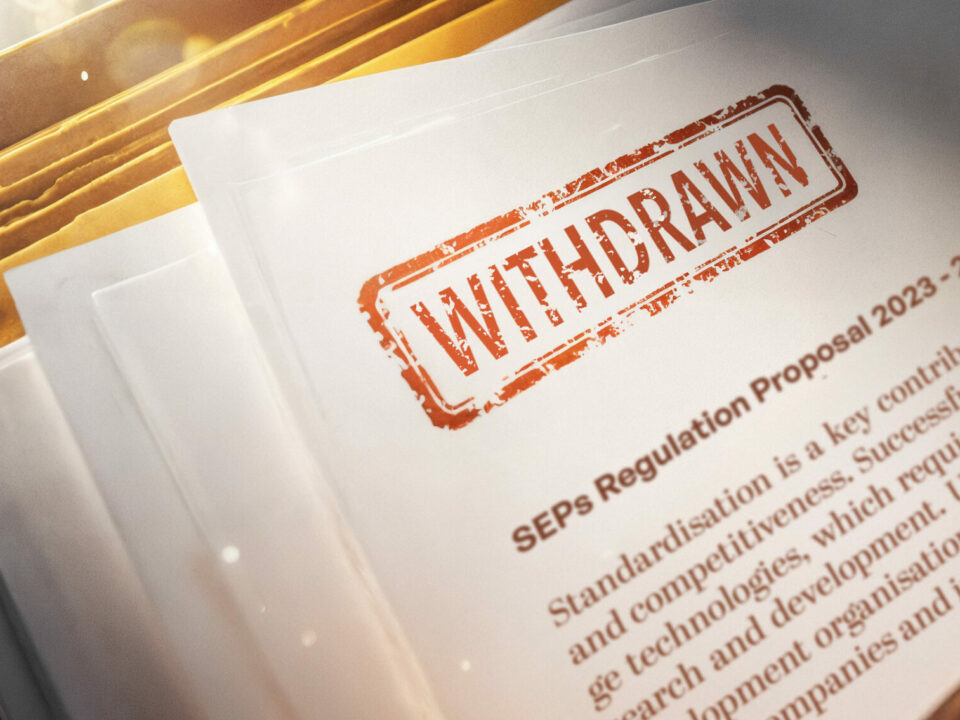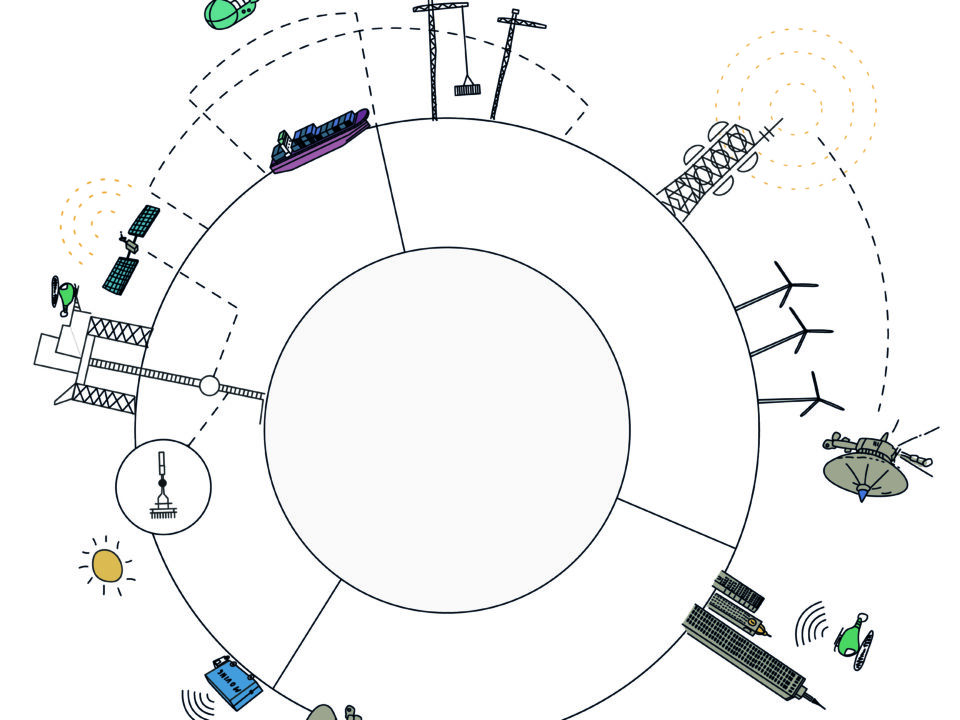Assessment needed: material developments in the SEP licensing landscape since 2023
In the two years since the Commission proposed its draft Regulation on Standard-Essential Patents, there have been several material developments in SEP licensing. These require the Commission to reconsider its approach to SEPs and undertake a new impact assessment before proposing any new regulatory initiatives.
Commission policies affecting standard essential patents (SEP) cut across the competences of numerous Commissioners and services, such as DG CONNECT (ICT standardisation), DG TRADE (global impact, WTO cases), DG RTD (fundamental research), DG JUST (access to courts) and DG DEFENSE (security, trusted partners).
Material developments since 2023 include (1) successful SEP licensing in automotive and Internet of Things; (2) increased SEP transparency initiatives; (3) new and successful European patent litigation mechanisms; (4) the EU’s new cross-cutting policy imperatives; (5) the EU’s red tape reduction imperative, and (6) evolving geo-strategic challenges.
These significant developments, summarised below, demonstrate that the Commission was correct to seek to withdraw the proposed Regulation. Unlike its original approach to the SEPs file, the Commission’s assessment of “whether another proposal should be tabled or another type of approach should be chosen” should take a whole-of-Commission approach. If regulatory initiatives are pursued, a new and comprehensive Impact Assessment (IA) should be undertaken, in compliance with the Council’s guidance, and must not undermine the EU’s new priorities nor existing market-based solutions.
Successful European SEP licensing
Most western automakers have now taken a license from the Avanci licensing platform, a one-stop-shop for licensing of 2G–5G connectivity in the automotive sector. Most western automakers benefit from licences at the reduced rate of $15 per vehicle for 2G-4G or $29 for 2G-5G (equating to under $2 or $3 per year over the 12-year lifespan of the average vehicle). Avanci continues to add new SEP holders to its platform, without changing the license fee (16 holders since 2023, bringing the total to 74). Access to these technologies enables automakers to generate significant revenues from connected car services, currently estimated to be around $120 per vehicle per year,i which offers automakers substantial profit margins.
SEP licensors and licensees also continue to reach successful bilateral SEP licenses: between 2023 and 2025, for example, SEP holders concluded amicable licensing agreements with Apple, Samsung and Honor, among others, during that period. In addition, patent pools have been successful in licensing in the IoT space, such as Sisvel’s programmes for smart grid, Wi-Fi and audio & video decoding licensingii, with new solutions continuously being launched to meet evolving market needsiii. This shows that there is no market failure that a new regulation needs to address, but rather that the market has already proposed efficient solutions to the evolving needs of all market players. Any new Commission initiative must factor in these market developments to avoid distorting market-based solutions or market dynamics.iv
ETSI, EPO and WIPO transparency initiatives
Despite the multiple reference to ETSI in the 2023 IA, the IA did not consider the impact of duplicating ETSI’s existing SEP disclosure database, which led ETSI to urge the Commission to reconsider the Regulation. In addition, the European Patent Office (EPO) has engaged in its own SEP landscaping, publishing its Patent Standards Explorer in May 2025, which compiles datasets from its unique prior-art databases, drawing in over 5.5 million documents collected from Standard Development Organisations (SDO), as well as European SEP court decisions. ETSI has improved its governance (partly due to the EU Standardisation Strategy), increasing the participation from additional stakeholders and finding new ways of involving SMEs. Finally, WIPO in 2024 launched its own SEP Strategy, which also covers transparency initiatives.
New European Patent litigation and dispute resolution mechanisms
The Unitary Patent Court (UPC) has specific competence to deal with SEP-related litigation, including cost reductions and simplification for SMEs. The EPO found that, since its establishment on 1 June 2023, the UPC “is becoming the forum of choice for disputes over standard essential patents”,v with the recognised competence to adjudicate FRAND licensing rates. Since 2014, SEP-related litigation has only gone downvi and, as the UPC is now involved in all the recent cross-border SEP disputes, parallel litigation in Europe is further reduced. In addition, in 2025, the UPC is launching a Patent Mediation and Arbitration Centre, providing a dedicated forum for resolving global SEP disputes.
The 2023 IA ignored the potential impact of the UPC, leading the President of the UPC Court of Appeal to criticise the proposed Regulation the Regulation for jeopardising Europe’s role as a trusted venue for SEP dispute resolution. Any new Commission initiative must factor in, and not undermine, the EU’s new SEP dispute resolution mechanisms. jeopardising Europe’s role as a trusted venue for SEP dispute resolution.
The European Union’s new policy imperatives
Since the Regulation was proposed, the EU’s high-level priorities have shifted towards deregulation and policies to promote innovation and competitiveness, especially in the digital technology sphere. In particular, the Commission’s 2025 Competitiveness Compass and recent International Digital Strategy for the European Union (adopted with the High Representative on 5 June 2025) clearly identify the need to maintain and, indeed, increase the EU’s influence in international standard setting to ensure outcomes align with the EU’s interests i.e. helping industry maintain competitive positions in key 5G/6G and IoT technology markets.
That Strategy also stresses the EU’s reliance on “a strong research and innovation base, world-leading tech companies and many innovative SMEs and start-ups that need to be encouraged to take part in international standards setting”. Yet, the draft Regulation placed all the costs and compliance burdens on SEP holders, with the IA recognising that the “majority of quantifiable benefits will accrue to standards implementers” with the Regulation potentially lowering royalty returns. However, even while the regulation recognised the global nature of SEP licensing, the 2023 IA did not assess the impact of the regulation on the international competitiveness of EU SEP holders nor on the EU’s standards leadership, notably through ETSI, which coordinates the 5G/6G work of 3GPP. Tellingly, the Parliament proposed that the Commission evaluate the Regulation’s possible negative impact on EU companies engaged in technologies development for standardisation, only after the regulation’s entry into force.
The EU’s objective, set out in the International Digital Strategy, is to leverage standardisation to “strengthen the competitiveness of its industry, foster digital and tech sovereignty, and protect and promote its fundamental values and interests while pursuing international cooperation in standard setting”. And, as noted in the Commission’s Call for Evidence for an Impact Assessment regarding Regulation (EU) 1025/2012, opportunities for simplification and reducing administrative burden must be prioritised. Given the Commission’s new imperatives, any SEP policies must motivate, not discourage, EU innovators to continue investing in risky R&D for critical, enabling technologies and must incentivise them to contribute technologies to open standards development.
Better and smarter regulation
The Competitiveness Compass committed the Commission to reduce administrative burdens and encourage investment in leading technologies. The Competitiveness Council, 22 May 2025, referring back to the Competitiveness Compass, re-emphasised the need to “drastically reduce administrative, regulatory and reporting burdens, as a matter of urgency”, to ensure regulations are fit for the EU’s competitiveness. Any SEP regulatory approach should therefore avoid unnecessary compliance burdens and discouraging investments, competition, research and innovation. As set out in the May 2025 Competitiveness Compass Conclusions, dynamic IAs must also consider the cumulative impacts of new obligations, avoid regulatory duplication or inconsistent provisions, including for significant implementing or delegated acts. The Council agreed that improving regulation and simplifying processes are a priority for all EU institutions.
However, the draft Regulation’s raison d’être, under the guide of transparency, is specifically to impose more, often duplicative, compliance, reporting, registration, and procedures, etc. and do so only on SEP holders, whether large or small. In addition, significant changes were made to the draft text after the Regulatory Scrutiny Board’s original Opinion, e.g. the scope of the Regulation extending to existing standards, and the Parliament added new provisions, e.g. that any company in the value chain can seek a license, which could negatively affect industry-wide licensing practices. Such changes require a revised IA in themselves. For all the reasons above, any new regulatory initiative must be tested against the EU’s new “Red Tape” principles and new policy imperatives.
Evolving geo-political challenges
Technology standardisation leadership is recognised as vital to the EU’s strategic autonomy, security and resilience. The 2023 IA did not assess the impact of the Regulation on ETSI’s leadership role in global cellular standardisation. Undermining Europe’s involvement in international SDOs will negatively impact Europe’s capabilities and encourage other jurisdictions to take the lead in developing technology standards e.g. India’s Bharat 6G Mission, aiming to hold 10% of 6G patents. China’s 2035 standardisation strategy is more advanced. For example, the Sparklink Alliance, a shortrange wireless IoT standard (NearLink) is being developed to reduce China’s reliance on international standardsvii and can be disseminated through China’s Belt and Road network. At the same time, Chinese courts fix legally binding global SEP rates that negatively affect EU SEPs holders’ rights outside China (resulting in two WTO cases brought by the Commission) against China, while Chinese automakers are not obtaining SEP licenses.viii Undermining international standardisation efforts leads to proprietary solutions, which can have significant security implications e.g. the Commission’s concern about the impact on the war in Ukraine of the Starlink wireless network being shut off, other ”kill switches” in imported technology or Chinese infrastructure network components.
None of these critical issuesix were considered in the IA. Any new regulatory approach must consider these questions and avoid undermining the ability of European SEP holders or trusted allies from participating in SDOs, which is vital to ensure technology leadership and secure digital infrastructure.
Conclusion
The significant developments set out above demonstrate that the draft regulation and accompanying IA are out of date with current market and geopolitical realities. The IA was already wholly insufficient at the time, ignoring the impact on the EU’s global competitiveness in advanced technologies. The rationale for the Regulation (increase in transparency and predictability) would not result from this regulatory approach and distort ongoing efforts. The Commission needs to take stock and consider the broader impact across its various competences. In addition, meaningful engagement with all players, including ETSI, EPO, UPC and the SEP community, which was notably absent for the Commission’s original SEP proposal, is essential for the legitimacy (and appropriateness) of any new initiative.
IP Europe stands ready to assist the Commission to reflect what a proportionate response to promoting transparency and predictability in SEP licensing would look like in the existing international market and geo-political context.
—
i For a summary on how automakers extract value from connectivity, see here. See also Sarwant Singh,Car Companies Can Generate $1,600 Per Car In Future From Connected Car Services, Forbes, 24 April 2024), here.
ii – See Sisvel Cellular IoT, here. See also Eric Stasik, How patent pools are powering the smart meter revolution, 30 May 2025, see here.
iii See Sisvel other licensing programmes here, including Wi-Fi, as well Avanci’s programmes for smart meters and EV chargers, here.
iv For an alternative approach, see the UK IPO’s guidance for SEP licensing, 22 July 2024.
v See here.
vi While in 2014 there were 249 citations of “FRAND” in worldwide patent litigation, in 2019, 2020, and 2021 there were 52, 32, and 3 respectively. See Dr. Justus Baron et al., Empirical Assessment of Potential Challenges in SEP Licensing, European Commission, 2022.
vii See e.g. Jingyue Hsiao, Huawei’s NearLink wireless technology signals a decoupled connected world, DIGITIMES Asia, 3 October 2023 here.
viii See Directorate-General for Trade and Economic Security, Report on Intellectual Propert Rights in Third Coutries, Counterfiet & Privacy Watchlist, 22 May 2025, here.
ix For short analyses of draft SEP Regulation impact on security see here (of 2024) and here (of 2025).




